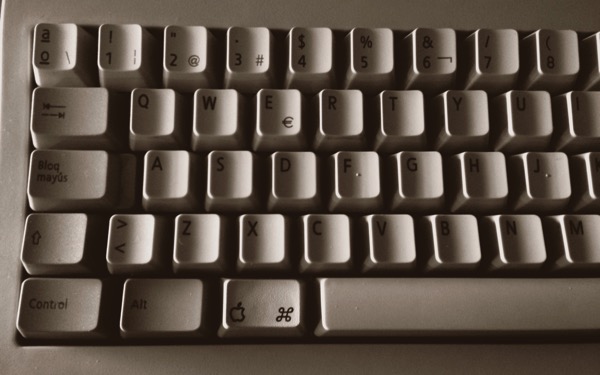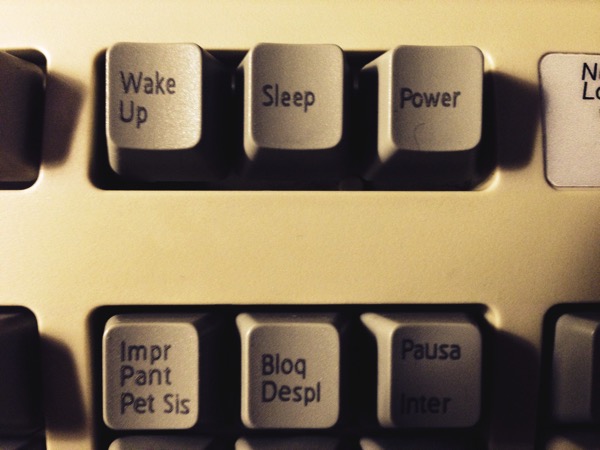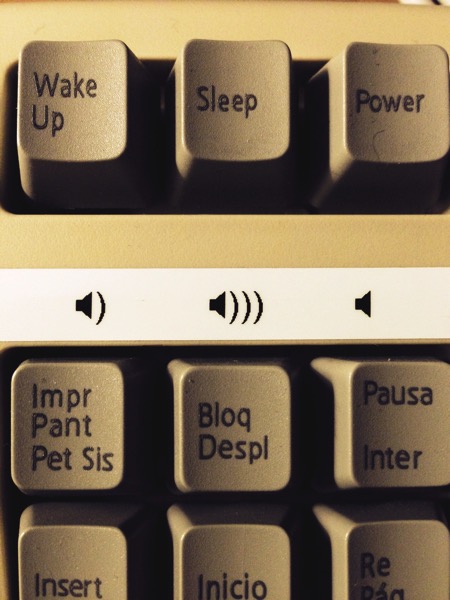While I don’t have particular problems typing on flat keyboards with scissor-switch mechanisms, or membrane-based mechanisms, I honed my typing skills on fully mechanical keyboards, and I’ve always tried to go back to a mechanical keyboard for my main setup (currently a 2009 MacBook Pro often in desktop configuration). One of the most practical and rather comfortable keyboards I’ve used for a long time was the 2003 Apple Wireless Keyboard (A1016). While not being a fully mechanical keyboard (it’s technically a dome-switch keyboard), the shape and feel of its keys provided a similar experience; typing was comfortable; it was a full-size extended keyboard; and it was wireless. I used it until it broke down and a fair amount of keys stopped responding.
Its replacement was equally great if not superior. After finding a Griffin iMate (ADB-USB adapter), I could go back to my true favourite among Apple keyboards, the Apple Extended Keyboard II. This setup lasted another good while, then the ‘P’ and ‘M’ keys started acting up and I had to switch to the second-best option I had at the time — the Apple Desktop Bus keyboard (A9M0330), the first ADB keyboard, introduced with the Apple IIGS. After this keyboard showed issues with the ADB connector, I turned to the Apple Standard Keyboard (M0116).
I kept using the Apple Standard Keyboard until the iMate stopped working. My backup plan, while looking for another iMate, was to use an Apple Pro Keyboard (M7803). Then, recently, in the tech recycle bin at the university library where my wife works, I found a discarded vintage-looking PC keyboard made by BenQ. Touching its keys, they gave that pleasant clicky response, not the muffled, mushy feedback so many modern PC keyboards give. The interface was PS/2, not USB, so I figured it was vintage enough. I proceeded to free it from other pieces of electronic junk, and took it home. I would test it, see if all keys were recognised, and in case the keyboard turned out to be dead or otherwise unusable, I would return it to the recycle bin myself the day after.
But in order to connect it to my Mac, there was something I had to get first: a PS/2-to-USB adapter, of course. Given that it’s not exactly a trendy device, I figured it would have been hard to find in a brick-and-mortar shop; but before returning home and trying online, I decided to go to the city centre and try my luck. And lucky I was! For €15, I found exactly the adapter I was looking for, made by Hama, and it was the last unit on display. Was this a sign, I wondered. And what if the keyboard turned out to be faulty? Well, an adapter such as this is always useful; if the keyboard doesn’t work, I’ll just look for another mechanical PC keyboard with a PS/2 connector.
(By the way, the adapter is very nice, it’s Y-shaped because at the PS/2 end, it actually splits and has two connectors, for keyboard and mouse.)
Anyway, once I got home, I immediately connected everything and tried the keys. By another stroke of luck, the BenQ keyboard was fully functional. All keys were recognised, all keys gave a consistent feedback and nothing appeared broken. The keyboard had been discarded simply because it was of no use anymore. Until now. What remained to be done was:
- Getting more information on the keyboard
- Cleaning the keyboard
- Remapping some keys to make it more Mac-friendly
More information on the keyboard
After a brief search on the Web, I found the exact model and more details on this page in the Deskthority forums. That is exactly the keyboard I rescued, a BenQ 6312-TA with Spanish layout. It appears to have been manufactured in 1999. Now, the original poster says this keyboard has Acer keyswitches, and another points out that this BenQ is actually a rebranded Acer keyboard. That piqued my curiosity, because I expected Alps keyswitches (the feel is similar to the Apple Standard Keyboard and Extended Keyboard I’ve used in the past). It turns out that — according to the Deskthority Wiki — The Acer switch is a spring-over-membrane switch from Acer. Acer switches are clicky and tactile and use Alps mount keycaps. The wiki also states:
Opinion on the feel of Acer switches varies, but the overall consensus is negative. The force curve is balky, similar to Xiang Min KSB series Alps clones, and to some the membrane feel is too obvious.
I must say I’ve been using this keyboard for about two weeks now, and I have no issues with the feel or feedback. All keys sound and behave uniformly, with the possible exception of the Enter key, which is just slightly softer.
Cleaning
Cleaning was, thankfully, a quick and trivial affair. Remove keys, apply compressed air, a gentle sweep with the vacuum cleaner, and the final touch with a soft cloth and a bit of mild detergent.
Remapping
When using PC Windows keyboards on a Mac, the first thing to do is to invert the position of the Alt and Win keys, because on a Windows keyboard, Alt is located where on a Mac keyboard you’d find the Command key, and the Win key is located where on a Mac keyboard you’d find the Alt/Option key. Then you go to System Preferences > Keyboard, click on the Modifier Keys button and do the remapping on the software side:

After doing this, I really disliked not having a real Apple ⌘ key, so I looked into my Apple ADB keyboard stash, and finally I found that the Command key of the Apple Design Keyboard was a nice fit. The profile is only slightly different, but it’s really nice having a key with the Apple logo. It’s even faster to find when typing Command+[key] shortcuts:

A couple of quirks
This keyboard has a Spanish layout, and Spanish labels on the keys. Well, not all keys, though. These are in English:

Also in English are the three labels of the LEDs on the right side of the keyboard above the numeric keypad — Num Lock, Caps Lock, and Scroll Lock.
Another funny thing: pressing and holding down the Power key turns off the display (like pressing Crtl-Shift-Eject), and it’s actually very handy since I keep forgetting that sequence of keys.
Moving down the middle section of the keyboard, the Mac recognises those three keys (Impr Pant/Pet Sis, Bloq Despl, and Pausa/Inter) as F13, F14, and F15 respectively:

Now, given that the only missing thing on the keyboard at this point are the media keys, and the media keys I use most often are Volume Up, Volume Down, and Mute, I thought about finding a way to map these functions to these F13, F14, F15 unused keys. After a brief search, I found out that these Services scripts written by Grant Skinner in 2011 for OS X 10.7 Lion still work under OS X 10.11 El Capitan. After assigning the ⌘-F13, ⌘-F14, and ⌘-F15 shortcuts to Volume Down, Volume Up, and Mute respectively (to mimic the position of the media keys in the Apple Pro Keyboard I was using before), I decided to give it a personal touch with an added label, to help me reach each function quickly:

Later I found an even better tool for keyboard remapping and customisation: Karabiner. As you can read in the online manual, Karabiner is a really powerful and versatile tool, especially useful if you’re a fan of custom mechanical keyboards with programmable or very different key layouts. For now I’m happy with my simpler solution, but I have downloaded Karabiner just in case.
Conclusion
It’s not like using my good old Apple Extended Keyboard II, but I’m very satisfied with the outcome of my little vintage rescue. For only the price of the PS/2-USB adapter, I now have a decent, pleasant mechanical keyboard again. My typing speed and accuracy are finally back at the levels I reached with past Apple and PC keyboards, and my fingers don’t hurt anymore after long writing sessions. Another advantage of this keyboard is that it’s more compact than the AEKII while offering a similar feedback. Another vintage peripheral still serving a purpose!
